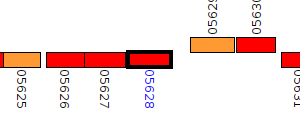In order to generate a more inclusive dataset of Pseudomonas genes mapped to putative in-paralogs and putative orthologs in other Pseudomonas species/strains, we developed a Pseudomonas Orthologous Groups classification system.
To generate ortholog groups, pair-wise DIAMOND searches were run on all genomes in the database to find reciprocal best hits (RBHs) for each gene. These analyses often resulted in multiple candidate genes for RBH status, which were narrowed down by examining the similarity between the query's flanking genes and the hit's flanking genes. If two candidate genes were directly adjacent, they where both accepted as RBHs that involve putative in-parology.
Pairwise intra-genome DIAMOND searches were also performed to acquire in-paralog information (i.e. gene duplications occurring after species divergence). If two genes in one genome were reciprocally more similar to each other than to any gene in the other genomes, the two genes were designated putative in-paralogs. Ortholog groups are built by starting with a seed gene and then adding all genes to which there is a RBH or in-paralog relationship.
Every new gene added to an ortholog group was then treated as a seed gene and the addition process was repeated until all qualifying genes had been added. The result was the development of orthologous groups, specifically generated for Pseudomonas species genomes, which can be used to sort search results.
Pseudomonas Ortholog Group POG000432
| Strain | Locus Tag | Description | Same-Strain Members | Fragment ? | |
|---|---|---|---|---|---|
| Pseudomonas aeruginosa BL19 | Q073_05628 |
phenylhydantoinase
|
2 same-strain members: Q073_05148 Q073_05628 |

|
|
| Pseudomonas aeruginosa BL20 | Q074_00496 |
phenylhydantoinase
|
2 same-strain members: Q074_00496 Q074_06077 |

|
|
| Pseudomonas aeruginosa BL20 | Q074_06077 |
dihydroorotase
|
2 same-strain members: Q074_00496 Q074_06077 |

|
|
| Pseudomonas aeruginosa BL21 | Q075_00453 |
phenylhydantoinase
|
2 same-strain members: Q075_00453 Q075_05816 |

|
|
| Pseudomonas aeruginosa BL21 | Q075_05816 |
dihydroorotase
|
2 same-strain members: Q075_00453 Q075_05816 |

|
|
| Pseudomonas aeruginosa BL22 | Q076_04610 |
dihydroorotase
|
2 same-strain members: Q076_04610 Q076_05089 |

|
|
| Pseudomonas aeruginosa BL22 | Q076_05089 |
phenylhydantoinase
|
2 same-strain members: Q076_04610 Q076_05089 |

|
|
| Pseudomonas aeruginosa BL23 | Q077_02204 |
dihydroorotase
|
2 same-strain members: Q077_02204 Q077_04375 |

|
|
| Pseudomonas aeruginosa BL23 | Q077_04375 |
phenylhydantoinase
|
2 same-strain members: Q077_02204 Q077_04375 |

|
|
| Pseudomonas aeruginosa BL24 | Q078_03346 |
dihydroorotase
|
2 same-strain members: Q078_03346 Q078_03842 |

|
|
| Pseudomonas aeruginosa BL24 | Q078_03842 |
phenylhydantoinase
|
2 same-strain members: Q078_03346 Q078_03842 |

|
|
| Pseudomonas aeruginosa BL25 | Q079_03362 |
D-hydantoinase/dihydropyrimidinase
|
2 same-strain members: Q079_03362 Q079_05449 |

|
|
| Pseudomonas aeruginosa BL25 | Q079_05449 |
dihydroorotase
|
2 same-strain members: Q079_03362 Q079_05449 |

|
|
| Pseudomonas aeruginosa BWH029 | AJ69_02377 |
phenylhydantoinase
|
2 same-strain members: AJ69_02377 AJ69_03684 |

|
|
| Pseudomonas aeruginosa BWH029 | AJ69_03684 |
dihydroorotase
|
2 same-strain members: AJ69_02377 AJ69_03684 |

|
|
| Pseudomonas aeruginosa BWH030 | AJ70_01682 |
phenylhydantoinase
|
2 same-strain members: AJ70_01682 AJ70_04319 |

|
|
| Pseudomonas aeruginosa BWH030 | AJ70_04319 |
dihydroorotase
|
2 same-strain members: AJ70_01682 AJ70_04319 |

|
|
| Pseudomonas aeruginosa BWH031 - Assembly GCF_000629105.1 | AJ71_03268 |
D-hydantoinase/dihydropyrimidinase
|
2 same-strain members: AJ71_03268 AJ71_03595 |

|
|
| Pseudomonas aeruginosa BWH031 - Assembly GCF_000629105.1 | AJ71_03595 |
dihydroorotase
|
2 same-strain members: AJ71_03268 AJ71_03595 |

|
|
| Pseudomonas aeruginosa BWH032 | AJ72_01812 |
phenylhydantoinase
|
2 same-strain members: AJ72_01812 AJ72_05306 |

|